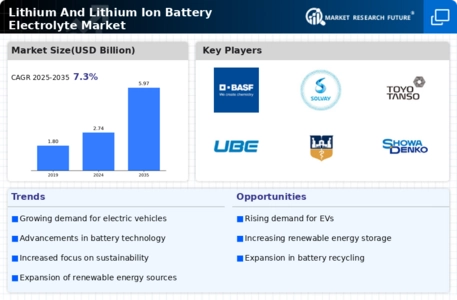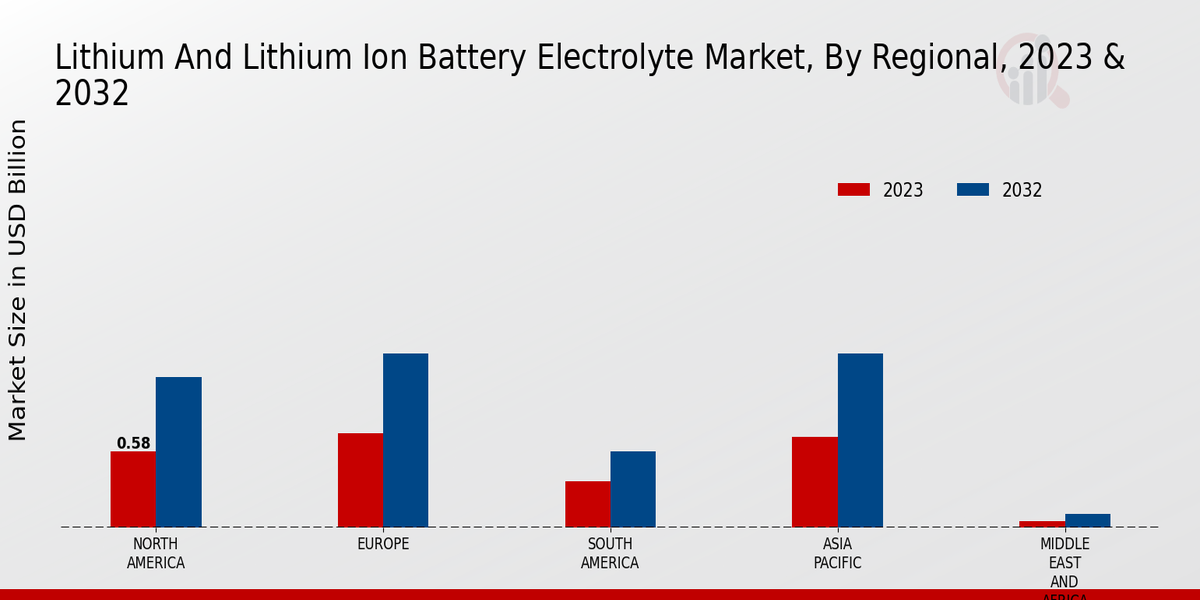Market Growth Projections
The Global Lithium And Lithium Ion Battery Electrolyte Market Industry is poised for substantial growth in the coming years. Projections indicate that the market will reach 2.74 USD Billion in 2024 and could expand to 5.97 USD Billion by 2035. This growth trajectory suggests a compound annual growth rate (CAGR) of 7.33% from 2025 to 2035. Such figures reflect the increasing demand for lithium-ion batteries across various sectors, including automotive, consumer electronics, and renewable energy storage, highlighting the electrolyte market's critical role in supporting this expansion.
Government Initiatives and Support
Government initiatives aimed at promoting clean energy and sustainable technologies are playing a crucial role in shaping the Global Lithium And Lithium Ion Battery Electrolyte Market Industry. Various countries are implementing policies and incentives to encourage the development and adoption of lithium-ion batteries. These initiatives often include funding for research and development, tax breaks for manufacturers, and support for infrastructure development. Such measures not only stimulate market growth but also foster innovation in battery technology, ensuring that the industry remains competitive and aligned with global sustainability goals.
Growing Consumer Electronics Market
The proliferation of consumer electronics is a significant driver for the Global Lithium And Lithium Ion Battery Electrolyte Market Industry. With the increasing reliance on portable devices such as smartphones, laptops, and tablets, the demand for efficient and reliable battery solutions is escalating. Lithium-ion batteries are favored for their lightweight and high energy density characteristics, making them ideal for these applications. As the consumer electronics market continues to expand, the need for advanced electrolytes that enhance battery performance will likely grow, further propelling the market forward.
Rising Demand for Electric Vehicles
The increasing adoption of electric vehicles (EVs) is a primary driver for the Global Lithium And Lithium Ion Battery Electrolyte Market Industry. As governments worldwide implement stricter emissions regulations and promote sustainable transportation, the demand for lithium-ion batteries, which rely heavily on electrolytes, is surging. In 2024, the market is projected to reach 2.74 USD Billion, reflecting the growing need for efficient energy storage solutions. This trend is expected to continue, with the market potentially expanding to 5.97 USD Billion by 2035, indicating a compound annual growth rate (CAGR) of 7.33% from 2025 to 2035.
Expansion of Renewable Energy Storage Solutions
The shift towards renewable energy sources is creating a substantial opportunity for the Global Lithium And Lithium Ion Battery Electrolyte Market Industry. As solar and wind energy become more prevalent, the need for efficient energy storage systems is paramount. Lithium-ion batteries, known for their high energy density and efficiency, are increasingly utilized in energy storage applications. This trend is expected to bolster the market, as energy storage solutions are essential for balancing supply and demand in renewable energy systems. The integration of lithium-ion batteries into these systems is likely to enhance their viability and drive market growth.
Technological Advancements in Battery Chemistry
Innovations in battery chemistry are significantly influencing the Global Lithium And Lithium Ion Battery Electrolyte Market Industry. Researchers are exploring new electrolyte formulations that enhance battery performance, safety, and longevity. For instance, the development of solid-state electrolytes promises to improve energy density and reduce flammability risks, which could transform the market landscape. These advancements not only cater to the growing demand for high-performance batteries but also align with the sustainability goals of various industries. As these technologies mature, they are likely to drive further investment and interest in the lithium-ion battery sector.


















Leave a Comment